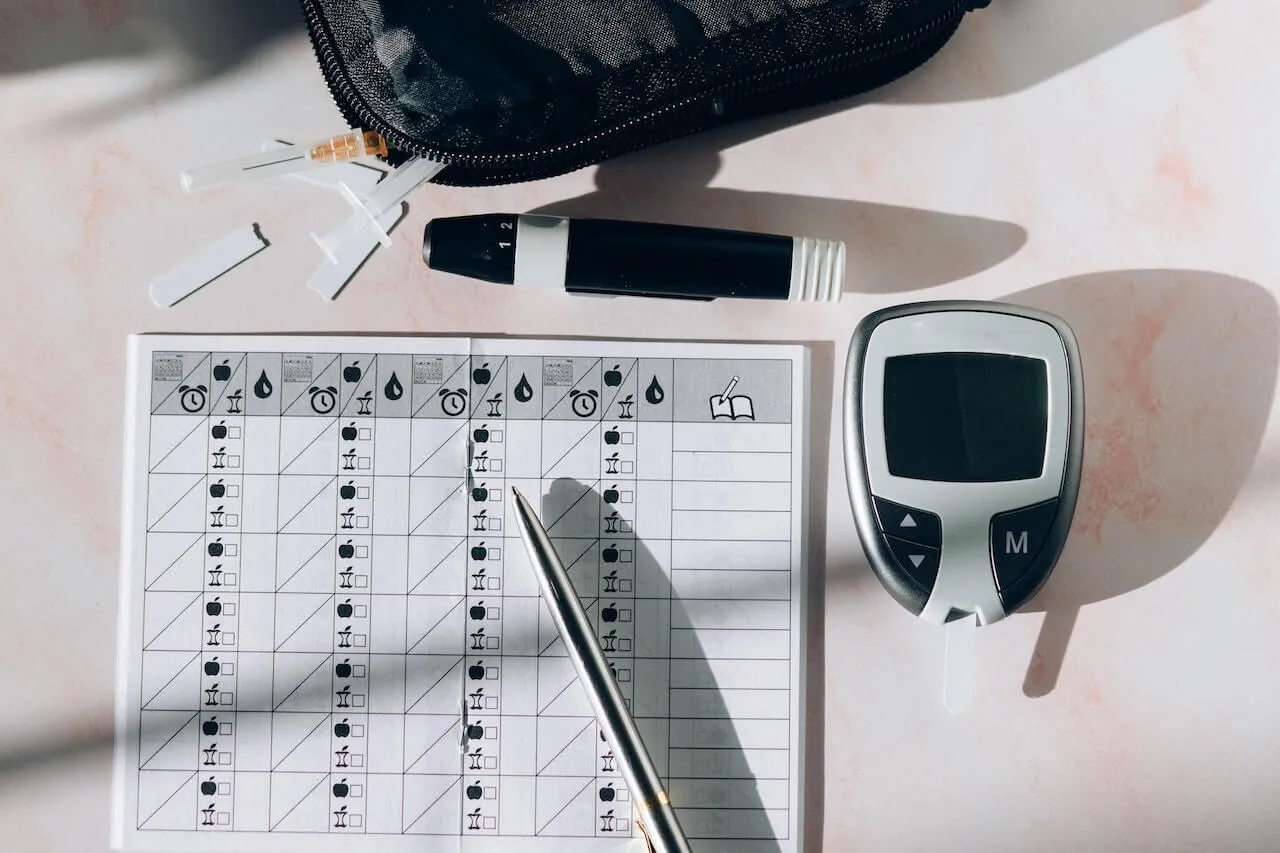A1c, or glycated hemoglobin, is a crucial measure for understanding your estimated average glucose (EAG) levels over the past three months. Monitoring the average glucose values can help you gauge how well you manage your type 2 diabetes or assess your risk of developing it. In this article, we'll explore how you can calculate this at home using a simple formula, empowering you to take control of your health.
{{mid-cta}}
What Is Hemoglobin A1c (HbA1c)?
Hemoglobin A1c (HbA1c) is a form of hemoglobin chemically linked to glucose in the bloodstream. It provides a valuable measure of average blood glucose levels over a period of approximately three months.
For people without diabetes, the normal range for A1c is typically below 5.7%. However, for individuals with diabetes, the target range is usually set by healthcare providers based on individual circumstances, but it is generally recommended to be below 7% to reduce the risk of diabetes-related complications. Regular monitoring of these levels is essential to managing diabetes and assessing the effectiveness of treatment plans.
The Importance of Knowing Your A1c Levels
By monitoring your A1c regularly, you can track how well you are managing your blood sugar levels and make necessary adjustments to your treatment plan.
Additionally, knowing your A1c test result can help you reduce the risk of long-term complications associated with diabetes, such as heart disease, kidney disease, nerve damage, and vision problems. Keeping them within the target range recommended by your healthcare provider can lower your risk of these complications and lead a healthier life.
A1c vs Blood Glucose Levels: What Is the Difference?
A1c and blood glucose levels provide different but complementary information about your diabetes care. Both can be completed through blood tests. Blood glucose levels, which are measured through daily monitoring, reflect your current blood sugar level at a specific point in time. These readings can fluctuate throughout the day based on factors such as food intake, physical activity, and medication use. One handy way to measure your blood glucose is with a continuous glucose monitor or CGM. On the other hand, A1c provides an average of your blood glucose levels over the past two to three months, offering a more comprehensive view of your overall blood sugar control.
While glucose monitoring, manually or with the help of a CGM, is useful for immediate adjustments to your diabetes care plan, the A1c test measures a more long-term perspective. It is typically measured every three to six months to assess your overall glycemic response to diabetes care and determine if changes to your treatment plan are necessary.
Understanding A1c Ranges
The following target A1c target ranges, recommended by the American Diabetes Association (ADA) and the Center for Disease Control (CDC), are crucial for glucose control and reducing the risk of long-term complications associated with diabetes.
Normal Range: Below 5.7%
Prediabetes Range: Between 5.7% and 6.4%
Diabetes Range: 6.5% or higher
How to Estimate A1c at Home

In this section, we will outline a step-by-step process for at-home A1c calculator. By monitoring your blood sugar levels, calculating the average, and using a simple formula, you can approximate your A1c. While this method provides an estimate and may not be as precise as a laboratory test, it can give you a good indication of your blood sugar control over the past few months.
1. Monitor Your Blood Sugar Constantly
Regular monitoring of your blood sugar levels is crucial for managing diabetes. Use a glucometer (or glucose meter) to complete blood tests at different times of the day, such as before meals, after meals, and before bedtime. Keeping track of these readings over time will help you understand your blood sugar patterns and assess your diabetes management.
2. Gather Your Readings and Determine the Average
Collect your blood sugar readings from your glucometer for a period of two to three months. Calculate the average of these readings to get a more comprehensive view of your blood sugar control over time. This average will serve as the basis for estimating your A1c levels. Use the A1c calculator below to compare against the standard ranges.
3. Use the Estimation Formula
Once you have determined the average blood sugar level (AG) over the past few months, you can estimate these values using the A1c calculator formula: A1c (%) = (AG + 46.7) / 28.7. This formula provides an approximation of your A1c based on your average blood glucose level. While this estimation may not be as accurate as a laboratory test, it can give you a good idea of your overall blood sugar control.
4. Compare Your A1c to the Standard Ranges
Once you have estimated your A1c, compare it to the standard ranges to assess your blood sugar control. A1c levels below 5.7% are considered normal, while levels between 5.7% and 6.4% indicate prediabetes. An A1c of 6.5% or higher is indicative of diabetes. If your estimated A1c falls outside the target range, discuss potential adjustments to your diabetes management plan.
What Are the Limitations of A1c?
While A1c is a valuable tool for assessing average blood glucose levels over time, several limitations must be considered.
While A1c is a valuable tool for monitoring long-term blood sugar control, several limitations should be considered. One limitation is that A1c does not provide real-time information about blood sugar fluctuations. Since A1c reflects average blood glucose levels over the past three months, it may not capture recent changes in blood sugar levels. This means that A1c may not accurately reflect blood sugar control in individuals with recent changes in medication, diet, or activity level.
Another limitation of A1c is that it may not be accurate in certain individuals. Factors such as age, race, and certain medical conditions can affect the relationship between A1c and average blood glucose levels. For example, in people with anemia or certain types of hemoglobin variants, A1c measurements may be inaccurate. Additionally, A1c may not be a reliable indicator of blood sugar control in pregnant women or individuals with conditions that affect red blood cell turnover.
<p class="pro-tip"><strong>Learn More: </strong><a href=what-is-a-continuous-glucose-monitor>How Does a Continuous Glucose Monitor (CGM) Work?</a>.</p>
9 Ways to Improve Your A1c

From monitoring carbohydrate intake to managing stress levels and adopting a regular exercise routine, these strategies can help stabilize blood sugar levels and improve overall A1c. By incorporating these lifestyle changes and making informed decisions about your diabetes management, you can take control of your health and improve your A1c.
- Measure Your Carb Intake: Monitoring and controlling your carbohydrate intake can help manage blood sugar levels. Aim to eat a consistent amount of carbohydrates at each meal and snack to prevent spikes in blood sugar.
- Reduce Your Stress Levels: Chronic stress can lead to elevated blood sugar levels. Finding healthy ways to manage stress, such as meditation, yoga, or talking to a counselor, can help improve A1c.
- Increase Your Exercise: Regular physical activity can help lower blood sugar levels and improve insulin sensitivity. Aim for a combination of aerobic exercise and strength training for optimal results.
- Balance Your Nutrition: Eating a well-balanced diet that includes a variety of fruits, vegetables, whole grains, lean proteins, and healthy fats can help stabilize blood sugar levels and improve A1c.
- Try Natural Sweeteners: Using natural sweeteners like stevia or monk fruit instead of sugar can help reduce your overall sugar intake and improve blood sugar control.
- Stay Hydrated: Drinking plenty of water can help flush out excess sugar from your bloodstream and prevent dehydration, which can affect blood sugar levels.
- Sleep Consistently: Getting enough quality sleep is important for blood sugar control. Aim for seven to nine hours of sleep per night and try to maintain a regular sleep schedule.
- Gather as Much Data as Possible: Keeping track of your blood sugar levels, food intake, exercise, and medication can help you and your healthcare provider identify patterns and make informed decisions about your diabetes management.
- Create a Routine to Take Care of Your Blood Sugar Levels: Establishing a regular routine for meals, snacks, exercise, and medication can help you manage your blood sugar levels more effectively and improve A1c over time.
Using a CGM with Signos: Real-Time Data, Backed by AI
Choosing the right medication is crucial for managing diabetes, improving overall health, and controlling weight loss. Medications for diabetes can help lower blood sugar levels, improve insulin sensitivity, and reduce the risk of complications. However, not all medications are suitable for everyone, and it's important to work with healthcare professionals to find the right medication for your specific needs.
Signos pairs a real-time glucose biosensor with AI trained on tens of millions of data points to deliver personalized, science-backed guidance for weight management and health. See exactly how your body responds, and take action.
Learn how it works. Ready to get started? Join now.
<p class="pro-tip"><strong>Also Read: </strong><a href=non-diabetic-track-their-glucose>Why Would a Non-Diabetic Want to Track Their Glucose?</a>.</p>



.webp)
.svg)










.svg)
.svg)
.svg)
.svg)
.svg)
.svg)
.svg)
